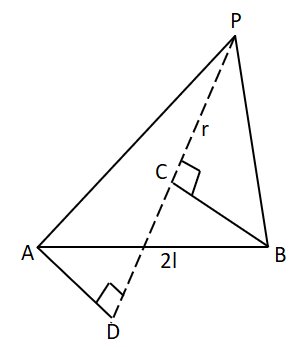
The value of electric potential at any point due to any electric dipole is:-
A. \[k\dfrac{{\overrightarrow P \times \overrightarrow r }}{{{r^2}}}\]
B. \[k\dfrac{{\overrightarrow P \times \overrightarrow r }}{{{r^3}}}\]
C. \[k\dfrac{{\overrightarrow P \cdot \overrightarrow r }}{{{r^2}}}\]
D. \[k\dfrac{{\overrightarrow P \cdot \overrightarrow r }}{{{r^3}}}\]
Answer
219.6k+ views
Hint:The electric dipole is a system of two charges that are separated by a finite distance. The dipole has a property called dipole moment which is equal to the product of the charges and the distance of separation between them. To find the value of electric potential at any point due to any electric dipole we use electric potential due to both charges.
Formula used: >
The potential due to this dipole is given as
\[V = \dfrac{1}{{4\pi {\varepsilon _0}}}\dfrac{{p\cos \theta }}{{{r^2}}}\]
Where p is dipole moment, r is distance from dipole, k is coulomb’s constant,\[k = \dfrac{1}{{4\pi {\varepsilon _0}}} = 9 \times {10^9}N{m^2}\] and \[{\varepsilon _0}\] is permittivity.
Dipole moment is given as,
\[p = q \times 2l\]
Where q is the charge and 2l is the distance of two charges.
Complete step by step solution:

Image: A point P is at some distance r from the dipole.
In figure AB the dipole of distance between them is 2l. Point P is at a distance r from the midpoint of AB.
BP=CP=OP-OC= \[r - l\cos \theta \]
AP=DP=OP-OD=\[r + l\cos \theta \]
Electric potential due to -q,
\[{V_1} = \dfrac{1}{{4\pi {\varepsilon _0}}}\dfrac{{( - q)}}{{AP}}\]
Electric potential due to +q,
\[{V_2} = \dfrac{1}{{4\pi {\varepsilon _0}}}\dfrac{{( + q)}}{{BP}}\]
Now electric potential at P can be:
\[V = {V_1} + {V_2}\]
\[\Rightarrow V = qk\left[ { - \dfrac{1}{{r + l\cos \theta }} + \dfrac{1}{{r - l\cos \theta }}} \right]\] where \[k = \dfrac{1}{{4\pi {\varepsilon _0}}}\]
\[\Rightarrow V = \dfrac{{qk2l\cos \theta }}{{{r^2} - {l^2}{{\cos }^2}\theta }}\]
As distance between the dipoles are less, so we can write;
\[{l^2}{\cos ^2}\theta \approx 0\]
Also we know that \[p = q \times 2l\]
By using these values in above, we get
\[V = k\dfrac{{pr\cos \theta }}{{{r^3}}}\]
\[\therefore V = k\dfrac{{\overrightarrow p \cdot \overrightarrow r }}{{{r^3}}}\]
Therefore the value of electric potential at any point due to any electric dipole is \[V = k\dfrac{{\overrightarrow p \cdot \overrightarrow r }}{{{r^3}}}\]
Hence option D is the correct answer.
Note: As we know electric dipoles consist of two charges equal in magnitude (q) but opposite in nature one is a positive charge and other is a negative charge. These two charges are separated by a distance. Electric potential obeys superposition principle due to electric dipoles as a whole can be sum of potential due to both the charges positive and negative.
Formula used: >
The potential due to this dipole is given as
\[V = \dfrac{1}{{4\pi {\varepsilon _0}}}\dfrac{{p\cos \theta }}{{{r^2}}}\]
Where p is dipole moment, r is distance from dipole, k is coulomb’s constant,\[k = \dfrac{1}{{4\pi {\varepsilon _0}}} = 9 \times {10^9}N{m^2}\] and \[{\varepsilon _0}\] is permittivity.
Dipole moment is given as,
\[p = q \times 2l\]
Where q is the charge and 2l is the distance of two charges.
Complete step by step solution:

Image: A point P is at some distance r from the dipole.
In figure AB the dipole of distance between them is 2l. Point P is at a distance r from the midpoint of AB.
BP=CP=OP-OC= \[r - l\cos \theta \]
AP=DP=OP-OD=\[r + l\cos \theta \]
Electric potential due to -q,
\[{V_1} = \dfrac{1}{{4\pi {\varepsilon _0}}}\dfrac{{( - q)}}{{AP}}\]
Electric potential due to +q,
\[{V_2} = \dfrac{1}{{4\pi {\varepsilon _0}}}\dfrac{{( + q)}}{{BP}}\]
Now electric potential at P can be:
\[V = {V_1} + {V_2}\]
\[\Rightarrow V = qk\left[ { - \dfrac{1}{{r + l\cos \theta }} + \dfrac{1}{{r - l\cos \theta }}} \right]\] where \[k = \dfrac{1}{{4\pi {\varepsilon _0}}}\]
\[\Rightarrow V = \dfrac{{qk2l\cos \theta }}{{{r^2} - {l^2}{{\cos }^2}\theta }}\]
As distance between the dipoles are less, so we can write;
\[{l^2}{\cos ^2}\theta \approx 0\]
Also we know that \[p = q \times 2l\]
By using these values in above, we get
\[V = k\dfrac{{pr\cos \theta }}{{{r^3}}}\]
\[\therefore V = k\dfrac{{\overrightarrow p \cdot \overrightarrow r }}{{{r^3}}}\]
Therefore the value of electric potential at any point due to any electric dipole is \[V = k\dfrac{{\overrightarrow p \cdot \overrightarrow r }}{{{r^3}}}\]
Hence option D is the correct answer.
Note: As we know electric dipoles consist of two charges equal in magnitude (q) but opposite in nature one is a positive charge and other is a negative charge. These two charges are separated by a distance. Electric potential obeys superposition principle due to electric dipoles as a whole can be sum of potential due to both the charges positive and negative.
Recently Updated Pages
Electricity and Magnetism Explained: Key Concepts & Applications

JEE Energetics Important Concepts and Tips for Exam Preparation

JEE Isolation, Preparation and Properties of Non-metals Important Concepts and Tips for Exam Preparation

JEE Main 2021 July 25 Shift 1 Question Paper with Answer Key

JEE Main 2021 July 22 Shift 2 Question Paper with Answer Key

States of Matter Chapter For JEE Main Chemistry

Trending doubts
JEE Main 2026: Application Form Open, Exam Dates, Syllabus, Eligibility & Question Papers

Understanding Uniform Acceleration in Physics

Derivation of Equation of Trajectory Explained for Students

Hybridisation in Chemistry – Concept, Types & Applications

Understanding the Angle of Deviation in a Prism

Understanding Atomic Structure for Beginners

Other Pages
JEE Advanced Marks vs Ranks 2025: Understanding Category-wise Qualifying Marks and Previous Year Cut-offs

Dual Nature of Radiation and Matter Class 12 Physics Chapter 11 CBSE Notes - 2025-26

How to Convert a Galvanometer into an Ammeter or Voltmeter

Understanding Centrifugal Force in Physics

JEE Main Marking Scheme 2026- Paper-Wise Marks Distribution and Negative Marking Details

Degree of Dissociation: Meaning, Formula, Calculation & Uses




